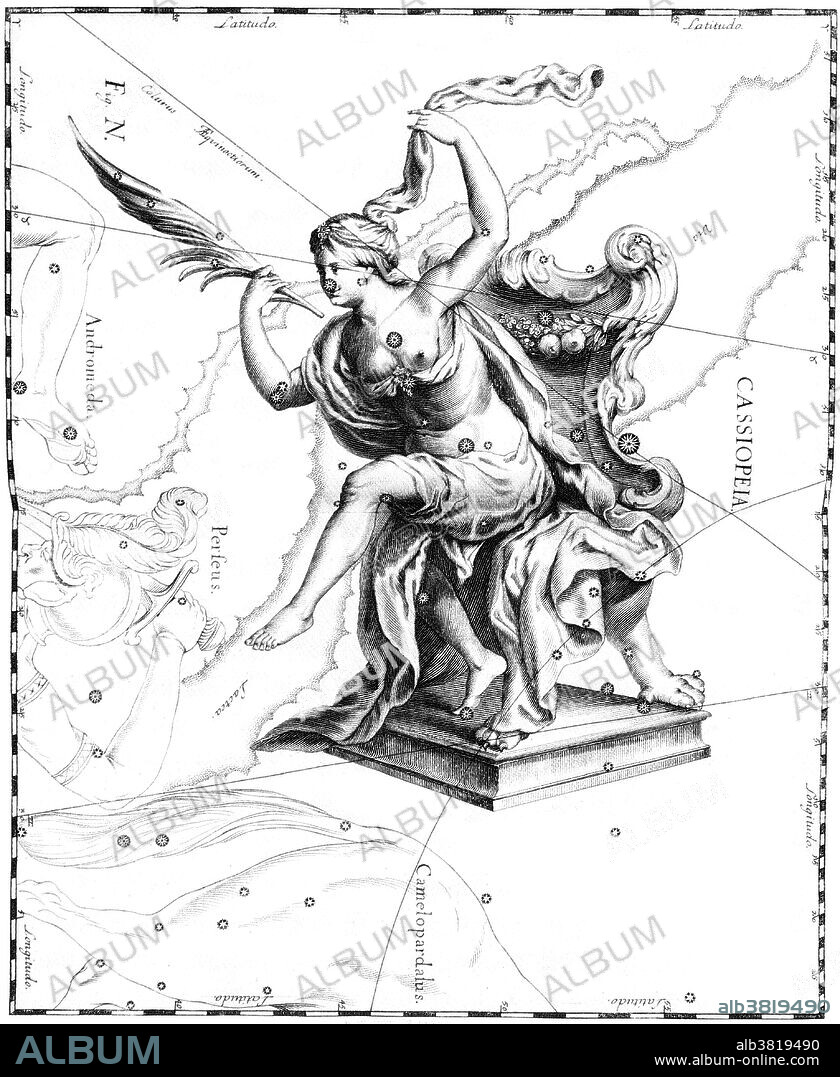alb3819490
Cassiopeia Constellation, Hevelius, 1687

|
Añadir a otro lightbox |
|
Añadir a otro lightbox |



¿Ya tienes cuenta? Iniciar sesión
¿No tienes cuenta? Regístrate
Compra esta imagen

Título:
Cassiopeia Constellation, Hevelius, 1687
Descripción:
Ver traducción automática
Cassiopeia constellation from Johannes Hevelius' Prodromus astronomiae, Firmamentum Sobiescianum, sive Uranographia, 1687. Cassiopeia is a constellation in the northern sky, named after the vain queen Cassiopeia in Greek mythology, who boasted about her unrivaled beauty. Cassiopeia was one of the 48 constellations listed by the 2nd century Greek astronomer Ptolemy, and it remains one of the 88 modern constellations defined by the International Astronomical Union. It is easily recognizable due to its distinctive 'W' shape, formed by five bright stars. It is bordered by Andromeda to the south, Perseus to the southeast, and Cepheus to the north. She is opposite the Big Dipper, and from northern latitudes can be seen at her clearest in early November. The Hevelius Firmamentum was the first star atlas to rival Bayer's Uranometria in accuracy, utility, innovation, and influence. Hevelius was perhaps the most active observational astronomer of the last half of the seventeenth century. His star atlas is notable for many reasons. It contains 56 large, double page engraved star maps. The star positions for the charts were derived from his own star catalog, based on his own observations, which was first published along with the atlas. It is unique among the Grand Atlases in choosing to depict the constellations as they would appear on a globe, that is, from the outside looking in, rather than from a geocentric point of view, as Bayer and most others adopted.
Crédito:
Album / Science Source / New York Public Library
Autorizaciones:
Modelo: No - Propiedad: No
¿Preguntas relacionadas con los derechos?
¿Preguntas relacionadas con los derechos?
Tamaño imagen:
3691 x 4500 px | 47.5 MB
Tamaño impresión:
31.3 x 38.1 cm | 12.3 x 15.0 in (300 dpi)
Palabras clave:
1687 • ARTE • ASTRONOMIA • ASTRONÓMICO • BLANCO Y NEGRO • CELESTE • CELESTIAL SPHERE • CELESTIAL • CIENCIA • CUERPO CELESTE • DIBUJO • ESFERA CELESTE • FAMOSA • FAMOSO • GRABADO • HISTORIA • HISTORICO • ILUSTRACION • IMPORTANTE • OBRA DE ARTE • SIGLO XVII
 Pinterest
Pinterest Twitter
Twitter Facebook
Facebook Copiar enlace
Copiar enlace Email
Email
